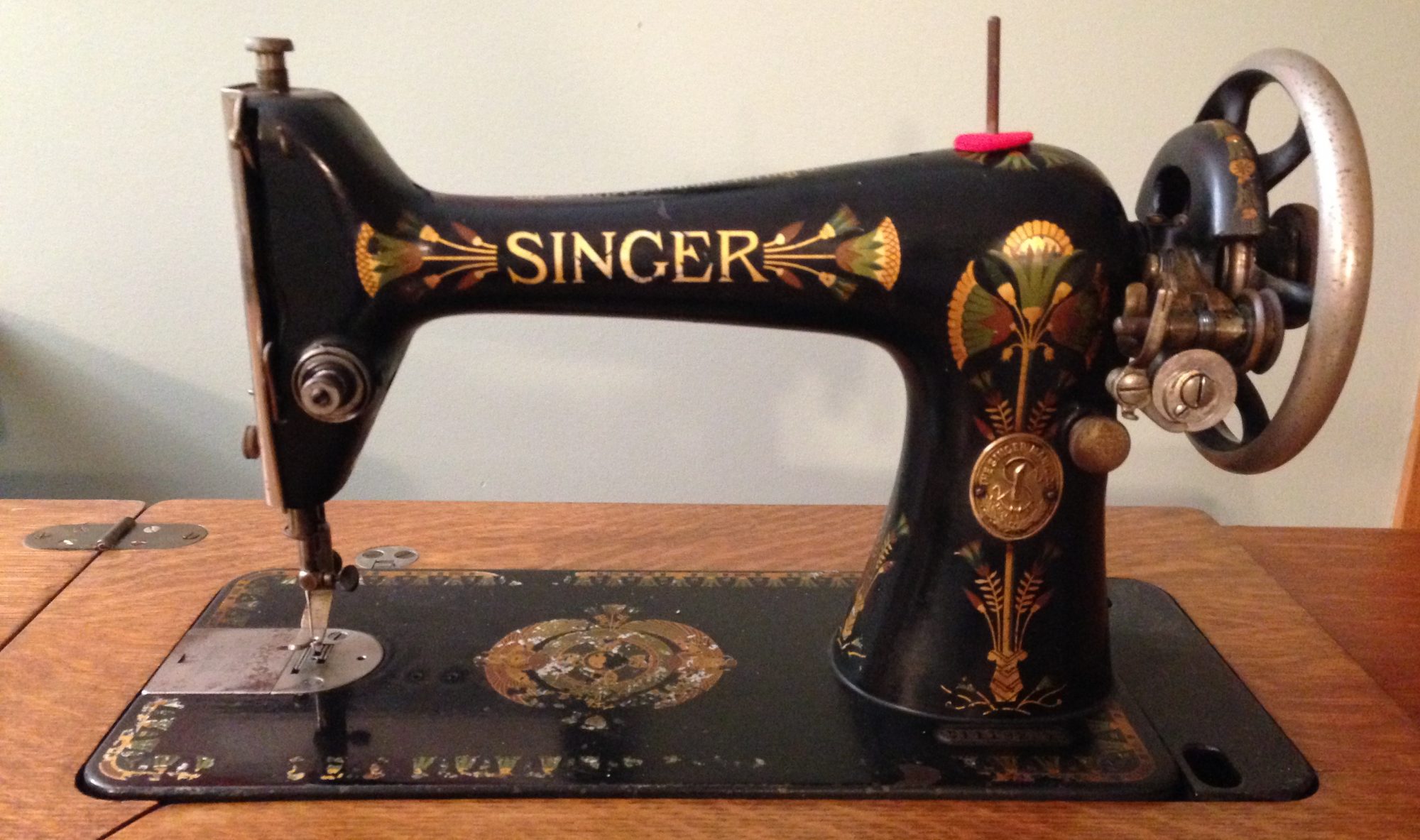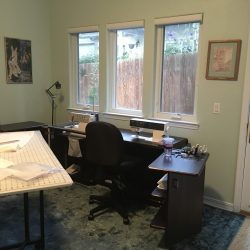The last time I posted, not much sewing was going on. Thankfully, I’m happy to report that a lot has changed since then.
After all of our remodeling projects were completed last Spring,

including (among several other projects) clearing and repainting our master closet space, my husband and I made a concerted effort to pull out clothes and shoes to be donated prior to moving everything back. We also participated in a neighborhood garage sale around that same time which provided a perfect opportunity to clear out even more items including a big bag of patterns I intended to sell on eBay but had never gotten around to doing. A wonderful sister-sewist took the whole lot off my hands in one fell swoop. Not to worry, I still have quite a large inventory remaining in my pattern stash. (See my previous post 🙂)
What a joy it was to finally set up my sewing space again at long last, but oddly, I found myself feeling a bit paralyzed about what to make next. There were a couple of semi-completed projects in the queue but no motivation to finish them. Maybe it was because those were winter related items and here it was well into Spring and coming in fast on summer with warmer weather with the promise of new breezy dresses and lighter pants and tops to contemplate making.
My summer dress muslins were completed but I knew I also wanted to make some linen blouses with embroidered embellishments. So I got out my tried-and-true Silhouette Patterns #600 “Classic Blouse” pattern:
https://silhouettepatterns.com/Classic-Blouse_p_543.html
which shouldn’t have presented any worries…but, not only were the original tissue pattern pieces pretty mangled, my traced and altered go-to pattern pieces were pretty marked up as well. You might be thinking, why not just trace out a clean version of the altered pattern? Well, not so fast; something was clearly holding me back.
After giving my hesitation some thought, I realized that even though I’d gotten my altered version to a point where it fit me reasonably well, there were still elements I wasn’t happy with, such as the location of the and drape of shoulder seam and sleeve. Even with a 3/8” shoulder slope adjustment, petite length adjustments between the neck and bust apex, and torso length, the drape of the blouse back hem tended to tilt out a bit from the hem. I also wasn’t happy with how the sleeve draped from my shoulder. Maybe it was time to make another muslin before steaming full speed ahead.
Around this same time I saw an advertisement for the GHF Couture masterclass, which covers creating a custom bodice block from one’s specific measurement then learning about the variety of dart manipulation and design choices. I decided to check it out and found the course to be highly useful and informative.
https://www.glamhfabrics.com/pages/ghf-couture-masterclass
I’ve always liked the concept of having well-fitting blocks (bodice, skirt, pant, jacket) from which to adapt different design elements. In fact, that was my original motivation for developing my “Classic Blouse” block as my go-to pattern and guide for creating several different tops such as tunics, dresses etc..
Since my previous blouse block still had issues, I decided to start afresh, using my current measurements and do a flat pattern bodice block comparison between three different pattern companies. “Design, Cut & Wear Professional”
https://www.etsy.com/shop/DesignCutAndWear
The bodice block pattern includes long shoulder and waist darts (this one I used for the GHF couture master class) Vogue 1004 (which includes side and waist darts) and “The Dress Kit” Bodice & Skirt blocks from Sure-Fit Designs also with side and waist darts).
Each option yielded new and useful positive fitting results, updated measurement information and fine-tuning.
With both the GHF Masterclass and SureFit Design methods, I managed to create reasonably well fitting bodice blocks, each with helpful reference information to go with moving forward. Vogue 1004 yielded similar results to other Vogue blouse patterns in my stash.
Perhaps most useful and one of my main “ah-ha moment” takeaways from the first two blocks I developed was the expressed importance of really nailing the bust apex location, not only the shoulder to apex, apex to waist and shoulder to waist length measurements, but also the apex to apex width measurement which ultimately affects the location of vertical darts as well.
It seems so obvious to me now, but even after decades of sewing experience, most of us home sewers spend countless hours trying to adapt our commercial patterns to fit whatever the pattern designer’s fit model’s proportions were for that particular pattern, including the height and width location of the darts. Turns out it’s not enough to simply size up or size down in pattern sizes to address circumference and length differences as the location of the bust apex width from center front will not necessarily be lined up correctly. When the apex width measurement isn’t accurate to begin with, the steps to alter, re-drape and fine-tune the fit tend to be much more labor-intensive as a result. Same holds true for just relying on one’s bust circumference measurements to determine pattern size selection.
Another revelation from my recent block comparison effort was something Glenda Sparling of Sure-Fit designs shared in one of her helpful YouTube tutorials regarding the order of shoulder adjustments; first, determine the correct shoulder seam width, then adjust for shoulder slope, followed by a forward shoulder seam location. I also found some excellent tutorials on YouTube from both Sure-Fit designs and JStern Designs about how to adjust the sleeve cap for these types of shoulder adjustments as well. Now I had a workable strategy for that well-draping sleeve I’d been looking for.
Regarding my forward shoulder adjustment; in my case, the back draping issues I’d experienced with my “Classic Blouse” muslin iterations (the CB hem tended to tilt out a bit at the hem which I’d first attempted to remedy by adding more length at the bottom) were not in fact caused by a rounded upper back as I’d originally thought, but rather, in my case, I needed to add 1/2” to my outer back shoulder seam tapering to nothing at the neckline and taking away the same amount from my front shoulder line. (my clue? the back neckline was sitting where it belonged on my neck and not pulling down and back). Previously I’d been taking away an equal amount (3/8-1/2”) from both the front and back outer shoulder seams which seemed to address excessive length in the front but wasn’t quite right in the back. Obviously the front and back pieces weren’t balanced on my body so simply adjusting for a shoulder slope adjustment equally wasn’t the ultimate solution.
So with all this fresh information and utilizing some newly-hewn proportional guidelines, (darts and shoulders) I literally went back to the drawing board and made another muslin of the “Classic Blouse” and guess what? Even though the length and circumferences of my previous attempts were similar, this latest muslin fit much better. I’m happy I spent the time developing something I will use with confidence Even though it slowed down my garment making productivity, it doesn’t feel like a waste of time in the least. I also look forward to sharing one of my new creations using my new and improved blouse (bodice block) in a future post.
In conclusion, it’s probably a good idea to make new pattern blocks every few years to address where our bodies are at that point.
****January 2024
My how time flies!
How did I do with my 2023 resolve not to buy any new patterns? Well, aside from the bodice block patterns, I believe I did fairly well for the first six months. I ultimately ended up with a list of ten or more patterns on my wish list and then found a couple of out of print patterns that really caught my eye on Etsy and Ebay. Knowing these would most likely not be available later, I decided to invest in those in short order. Of course, a couple of hard to pass up sales also came up last Fall so I ultimately decided to purchase a few patterns I knew were different and unique to those already my collection.
I still have my pattern wish list which continues to prove useful in the practice of waiting and reassessing what inspires me and what I’ll actually make.
I’ve also been using the patterns I already have in the last six months and this more conservative approach has yielded more intentional sewing across the board. More on these projects to come in future posts.
May this new year find all “makers” in our world full of inspiration, joy and creativity as we move forward in our craft.


Good to see another post and hear the latest. Gorgeous fireplace!
LikeLike